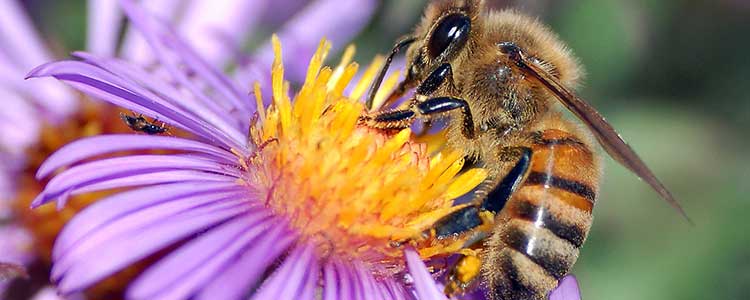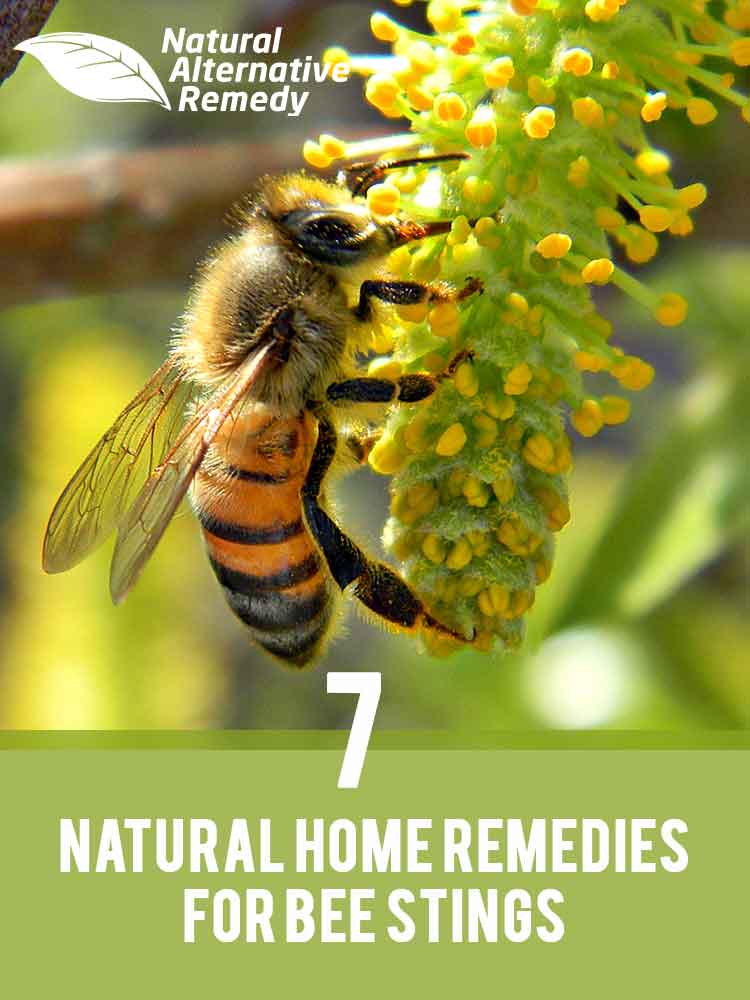
Sometimes a bee sting brings little more than an intense but fleeting burst of pain, followed by a small, red bump at the site of the sting. Often, however, even people without severe bee sting allergies find themselves unable to “shake it off,” finding the swelling, redness, and pain or itching persistent.
How to Treat a Bee Sting Naturally
Whether you’re a natural remedy family or the first to make a trip to the pharmacy, all bee sting treatment recommendations start with the same three-step process:
- Remove the stinger
- Cleanse the skin
- Ice
If you were stung by a honeybee or Africanized “killer” bee, the first step is to get the barbed stinger and attached venom sac out as soon as possible as the less bee venom released into your system, the less pain, itching, and swelling you’ll experience. Bumblebees and carpenter bees, on the other hand, can sting without leaving their stinger behind. Once safely away from harm, check your sting for remnants of a stinger.
A credit card or other straight-edged, sturdy material is ideal for scraping away the stinger. Try not use tweezers or your fingernails as your first removal tool of choice as squeezing the stinger may release more irritating venom into the wound and cause more trauma to your skin. But after the first minute or so during which most of the venom is released, the primary goal is to get the stinger out as even a small remaining fragment can cause infection and delayed healing.
If you can get to a bathroom or source of clean water, wash the area thoroughly with soap and water to help neutralize the venom and clean the wound. Applying an ice pack to the area every 20 minutes or so, for a period of 10 minutes at a time, helps reduce inflammation and pain.1 For most bee sting victims, these first few steps are enough to set the body up to heal itself, but they aren’t the only effective tools in your natural first aid kit.
Best Natural Home Remedies for Bee Stings
The most common reactions to bee stings typically heal on their own within three to seven days. To aid the healing process and relieve your symptoms, however, you may choose to use some additional natural home remedies.
After removing the stinger, cleaning the area, and applying ice, many physicians recommend basic drugstore products for bee stings such as calamine lotion or hydrocortisone cream for topical treatment or an oral antihistamine such as Benadryl when the itching and swelling persist. But these conventional chemical treatments come with their own risks and side effects. For treating a mild reaction to a common bee sting, there are natural alternatives that you may already have on hand. Many of the most effective natural bee sting remedies come straight from your medicine or kitchen cabinet.
1. Baking Soda Paste
A paste made of baking soda and just a bit of water is a simple home remedy for bee stings that works to relieve your symptoms at the source by neutralizing the bee venom. Even better, the paste adheres readily and dries on your skin. Mix enough paste to cover the site the of the sting and leave it on for about 30 minutes, repeating as needed.2 For extra healing power, try adding a drop or two of natural remedy #7 below!
2. Meat Tenderizer (Papain or Bromelain)
Papain, also known as papaya proteinase, is an enzyme found in papaya while bromelaim is an enzyme found in pineapple. Both naturally-occurring enzymes can be found in common meat tenderizers in which they are used to break down the proteins found in animal meat.3 Since bee venom is composed mainly of proteins,4 it is thought that papain and bromelain will break down the venom in your sting just as it does to your tougher cuts of steak to reduce your body’s reaction to the venom.
While many online sources boast that your average meat tenderizer powder is the way to go when it comes to treating bee stings, we’re less than convinced. Most store-bought meat tenderizers do contain papain or bromelain, but they also tend to contain lots of added ingredients like salt, spices, MSG, and preservatives, which may be less than ideal for your already irritated skin.
So rather than reaching for your name-brand meat tenderizer powder, we recommend applying a natural liquid papain or papain powder and water paste to your sting if you just so happen to have it on hand. Leave your papain enzyme treatment on the sting in a thin coat for no more than 30 minutes.
3. Natural Toothpaste
Moving out of the kitchen and into the bathroom, you’ll find that most natural toothpastes contain alkaline ingredients that have many of the same acid-neutralizing properties as baking soda. Since toothpaste products are already mixed and malleable, they offer a super quick fix for natural bee sting treatment. Just be sure to use a trusted natural brand of toothpaste that doesn’t contain any of the harmful chemical ingredients of common toothpaste brands (like sodium lauryl sulfate). We like JASON brand toothpastes (particularly the Powersmile formula in Powerful Peppermint).
If your toothpaste of choice gets a minty fresh kick from natural peppermint essential oil, you may find that you get the added bonus of a natural cooling sensation that can also ease some of the pain.
Dab a pea-sized amount of toothpaste directly on the sting and leave for 20 to 30 minutes before washing away with cool water.5
4. Witch Hazel
Witch hazel, the natural astringent liquid readily found in drug stores and health food stores alike, works much like aspirin for pain and itch relief.6 Swab a small amount onto the sting with a cotton ball after cleansing the area.
Witch hazel extract or distillate is a must-have in every natural medicine cabinet; it’s one of the most versatile natural remedies for common skin ailments from hemorrhoids to mosquito bites. Want to be prepared for the most common summer skin concerns? Keep a bottle of witch hazel in the refrigerator during the summer to provide fast, cool relief for bites, stings, and sunburn.
5. Honey
If you can stand the irony, organic honey is an effective treatment for many common skin concerns, including bee stings. Honey has natural “drawing” powers, which aid in drawing the venom from your sting. Honey is also a natural disinfectant with added soothing and healing properties. Pat a drop or two onto the swollen, painful area and let it slowly dry for up to an hour.7
6. Plantain Leaves
Get to know the wild herb known as plantain (Plantago major and Plantago lanceolata) because being able to spot it can give you immediate itch relief while you’re still outdoors. Plantain is generally considered a common backyard weed, but it has also been known as a panacea of sorts for all things skin-related. It has a long history of use in the natural treatment of minor cuts, scraps, and skin reactions.
To use, pluck a few fresh leaves, chew or mash them with your fingernails or spoon to release their healing juices, and apply the mashed leaves directly to your sting. Just be sure to only use plantain leaves that have not been treated with chemical pesticides. To always have some healing plantain on hand, you can preserve plantain for several weeks in clear alcohol like vodka for a soothing tincture or in olive oil, which can be strained and heated with beeswax to make healing salves.[7. Griggs, Barbara. The Green Witch Herbal, Healing Arts Press (1994).]
7. Lavender Essential Oil
Lavender essential oil is known for its healing and analgesic, or pain-relieving, properties. We always keep a large bottle of our favorite brand on hand for everything from natural stress relief and air fresheners to healing sunburn treatments and natural bug repellent. It is, no doubt, one of the most versatile and useful essential oils to keep in your cabinet.
When applied to a bee sting, lavender essential oil’s antibacterial properties keep the wound clean, while it also goes to work to neutralize the bee venom and relieve mild pain. Though many sources say that lavender oil is one of the only essential oils that is safe to apply undiluted, we always recommend mixing it with your favorite natural carrier oil. We like sweet almond oil.
Try mixing 2-5 drops of lavender essential oil with a spoonful of carrier oil for a topical bee sting treatment that can be applied throughout the day as needed. We like keeping pre-mixed solutions on hand in these handy glass roller ball bottles.
Don’t have lavender essential oil on hand? Try tea tree oil, which can also be an effective natural remedy for bee stings.8 Just be sure to dilute it with carrier oil or water before applying to your skin.
When to Seek Medical Help
While these natural home remedies for bee stings are safe and appropriate for most people, it’s important to remember that some have life-threatening allergies to bee venom. If you or your loved one has a severe allergy to bee venom, seek immediate medical attention if stung. When treating bee stings at home, be on the lookout for symptoms of serious allergic reactions such as difficulty breathing, dizziness, nausea, fever, muscle spasms, or loss of consciousness.9 If you experience swelling in areas other than the site of the sting such as the face, lips, or around the eyes, you may be experiencing angioedema, another type of serious allergic reaction that requires medical attention.
As with all bug bites and stings, there is also always risk of infection. In addition to taking care to clean your hands and the skin surrounding the wound, watch for increased redness or streaking of the skin around the site of the sting, which are both signs of infection.
What home remedies for bee stings have you used? Share your story in the comments below!
Sources
- Insect bites and stings – www.umm.edu/health ↩
- Insect Sting Allergy Treatment – www.webmd.com ↩
- Why is papain an effective meat tenderizer? – http://antoine.frostburg.edu ↩
- The Chemical Composition of Insect Venom – www.compoundchem.com ↩
- Natural Bee Sting Treatment Options – www.motherearthnews.com ↩
- Witch Hazel – www.altmd.com ↩
- Natural Bee Sting Treatment Options – www.motherearthnews.com ↩
- Tea Tree Oil – www.drweil.com ↩
- Insect bites and stings – www.umm.edu/health ↩

